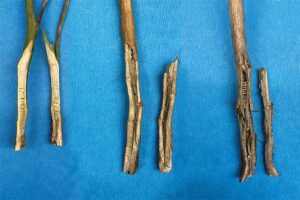Verticillium stripe management takes a step forward
The five-year (2019-2024) ‘Verticillium stripe management’ project investigated the disease development and made a few discoveries that will help with disease assessment and canola breeding to improve resistance.
Researchers measured yield losses in two ways: on a per-plant basis by growing plants in micro-plots inoculated at different densities, and by growing plants in six by 1.5 metre field plots harvested by a small-plot combine. They used greenhouse experiments to determine interactions between blackleg and verticillium stripe.
Weather conditions were wetter than average in the early growing season and resulted in good disease development in the 2020 field experiments. In 2021, precipitation was well below average in June and July and resulted in much lower disease development, however yield
losses still occurred.
Results
The research provided several outcomes we can learn from:
Infection at any stage can lead to yield loss.
Infection by verticillium stripe in the early stages inhibited canola establishment and growth. Later infection led to deterioration of the stem and vascular tissues. Infection at both stages affected yield and yield loss increased as the infections become more severe. Yield losses also occurred under dry conditions with few symptoms.
Application:
Reduce the risk of introducing verticillium stripe by reducing soil movement within and between fields.
This way if verticillium stripe fungal propagules, called microsclerotia, are in the soil, they will be less likely to enter or spread in a field. See how microsclerotia impacts the verticillium stripe disease cycle in the graphic (see image).

Longitudinal sections of the stem show the vascular discolouration restricted to the lower stem in blackleg, (a); verticillium stripe symptoms extended up the stem, with a hollow, darker centre (b) and a hollow and darker centre together with black discolouration were observed in stems infected by both diseases. Photo credit Dr. Yixiao (Becky) Wang
New scales can assess disease severity.
Researchers developed verticillium stripe disease severity assessment scales for early and later stage infections of canola.
Application:
The verticillium stripe steering committee has the goal of putting these assessment scales into an easily shareable format and distributing it to the canola industry. This could be used for field assessments and could benefit future canola breeding efforts.
Inoculation method improves disease screening.
Researchers refined methods for V. longisporum inoculation of canola, including using the root-dip method.
Application:
These are important tools for screening canola germplasm for disease resistance and evaluating verticillium stripe resistance.
Verticillium can make blackleg worse.
Extra measures may be needed to control blackleg where verticillium stripe is present.
Application:
Continue to implement/improve on blackleg management efforts, including using the CCC’s Understanding Blackleg Resistance guide to identify the resistance groups best suited for current pathogens in your fields, and then choosing canola cultivars accordingly.
Verticillium stem discolouration extends higher up the stem.
Longitudinal stem sections helped distinguish verticillium stripe from blackleg.
Application:
Use the Verticillium Stripe Field Scouting Guide, which includes images of longitudinal stem cuts, for proper identification and differentiation from blackleg. When submitting suspect stem samples for testing, request that they test for both verticillium stripe and blackleg.
Read the full summary and report on the Canola Research Hub at canolaresearch.ca.




